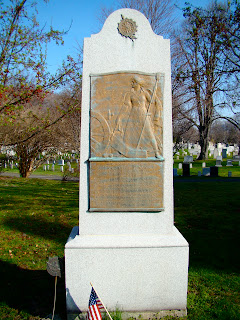Mar's building.
As I marched through the sally port at Fort Ticonderoga for the first time, I
couldn’t wipe the smile off my face. A bronze plaque placed at the entrance lists
the names of those who have walked through the doorway: Washington, Arnold,
Allen, Franklin, Montcalm, Carleton, Burgoyne, Andre and Fort Montgomery’s
namesake, General Richard Montgomery, had all walked through this historic passage.
The plaque of names.
Stepping inside, I took in my cold stone surroundings. I’d never seen anything like it. We brought our gear into the barracks building and each found a bunk. Straw mattresses should make for a comfy night, I thought to myself. The commander called us outside; there is much work to be done!
Firewood needed stacking and cutting and the flint and steel were fetched.
Learning began in earnest as we watched one of our group strike a rock against
a small piece of metal into a char cloth. It really made matches seem superfluous!
The char cloth flared right up and a few minutes we had ourselves a hot fire. What
a dichotomy that I had my first lesson in fire making at Oriskany at 6:00 in
100 degree heat, now I had lesson two at 30 degrees in the snow.
We were surrounded by three massive stone barracks like
buildings, walls high above our heads, and cannons lining every wall. It is a breathtaking sight, to say the least,
though before I can explore, the regiment is called to fall in; it is time for
a patrol.
“Flankers!” 1st Sgt. Chris called, as a ranger-green clad Pvt. Neil and I run to out spot on the sides of the patrol. We wandered into the King’s Garden and I took in the lay of the land. I was astounded when I was told that every hill in the ground that looks manmade probably was. Redoubts and earthworks lined the roadsides.
Going out on patrol.
We ventured down to a 19th century boat house
that was used as a dock for the ferries that once travelled Lake Champlain. Pvt.
Neil and I ran ahead and secured the remnants of the building and gave the
clear sign to the rest of the party. It was explained that the American bridge
to VT wasn’t far from where we were. A French Battery was built on the hill
next to us.
Pvt. Neil with Vermont in the background.
We eventually came to the Pell playhouse and 1st
Sgt. Chris explained the Pell’s built this house for their children next to
their mansion. It is of log construction
with glass windows and a log loft. The fireplace alone was impressive! To
replicate today would cost tens of thousands of dollars. The Pell mansion
stands not far off also in sad shape, but at least still holds its structural
integrity. In its heyday, it was most certainly a proud building. A blue historical marker in the front yard
tells the story of Samuel Champlain fighting off Indians not far from this spot
in 1609!
The Pell mansion with signage of Samuel Champlain.
The patrol ventured farther up the road and the conversation switched to the 42nd Highlanders. We head in the direction of their famous charge at the French lines and fire a volley or six along the way. After practicing some light infantry tactics, we traversed the road and came to the zig-zag of the beautiful French Lines. Used by Montcalm to stop a much larger British army in the French and Indian war, these earthworks are very well preserved after being rebuilt by the Americans during the revolution. We headed into the woods and halted where the New York and New Jersey provincials were stopped at the abatis.
The French Lines near the NJ/NY attack.
The 5th NY takes in the Highlander monument.
After a brief discussion of fortifications, we headed to the Highlanders
monument, commemorating the futile charge the Scottish made against the French
line. It was the most successful engagement of the battle but the French
repelled them once they reached the wall. Here, there is a beautiful stone
monument with rocks brought from Scotland. Our final stop on the grounds patrol
sent us to the mass grave of the NY,NJ, and PA soldiers. We fired off a volley in salute and made the
trek back to the Fort. On the way back I
noticed redoubt after redoubt surrounding us.
It was an amazing feeling to be there.
The rest of our experience at Fort Ticonderoga involved cooking and duties that soldiers did 230 years and beyond ago. Drilling and parapet firing practice tested and reinforced our skills. At night, we had freshly baked bread and enjoyed a soldier’s stew over the fire. As I walked in the darkness around in the fort by myself, I thought that this was an experience I would never forget.
The rest of our experience at Fort Ticonderoga involved cooking and duties that soldiers did 230 years and beyond ago. Drilling and parapet firing practice tested and reinforced our skills. At night, we had freshly baked bread and enjoyed a soldier’s stew over the fire. As I walked in the darkness around in the fort by myself, I thought that this was an experience I would never forget.
Cooking a soldier's stew.
And so concludes part I. Stay tuned for the next days travels to Fort St. Frederic, Fort Crown Point, and a brief stop at Fort William Henry!
















